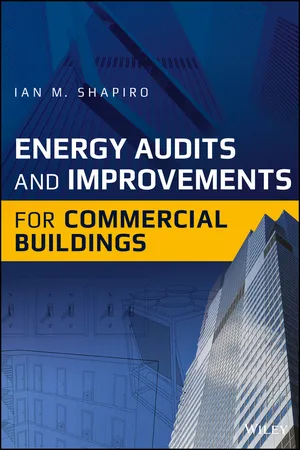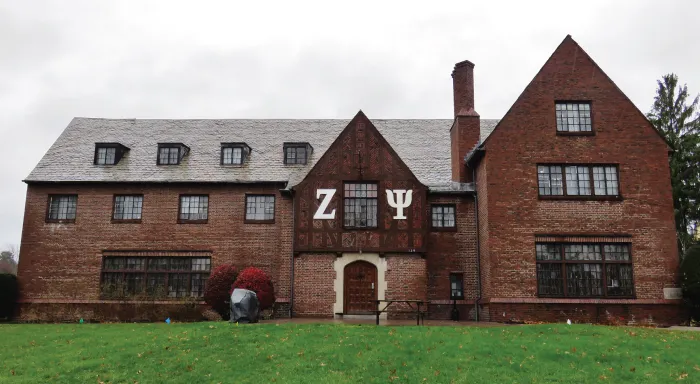
- English
- ePUB (mobile friendly)
- Available on iOS & Android
Energy Audits and Improvements for Commercial Buildings
About this book
The Intuitive Guide to Energy Efficiency and Building Improvements
Energy Audits and Improvements for Commercial Buildings provides a comprehensive guide to delivering deep and measurable energy savings and carbon emission reductions in buildings. Author Ian M. Shapiro has prepared, supervised, and reviewed over 1, 000 energy audits in all types of commercial facilities, and led energy improvement projects for many more. In this book, he merges real-world experience with the latest standards and practices to help energy managers and energy auditors transform energy use in the buildings they serve, and indeed to transform their buildings.
- Set and reach energy reduction goals, carbon reduction goals, and sustainability goals
- Dramatically improve efficiency of heating, cooling, lighting, ventilation, water and other building systems
- Include the building envelope as a major factor in energy use and improvements
- Use the latest tools for more thorough analysis and reporting, while avoiding common mistakes
- Get up to date on current improvements and best practices, including management of energy improvements, from single buildings to large building portfolios, as well as government and utility programs
Photographs and drawings throughout illustrate essential procedures and improvement opportunities. For any professional interested in efficient commercial buildings large and small, Energy Audits and Improvements for Commercial Buildings provides an accessible, complete, improvement-focused reference.
Frequently asked questions
- Essential is ideal for learners and professionals who enjoy exploring a wide range of subjects. Access the Essential Library with 800,000+ trusted titles and best-sellers across business, personal growth, and the humanities. Includes unlimited reading time and Standard Read Aloud voice.
- Complete: Perfect for advanced learners and researchers needing full, unrestricted access. Unlock 1.4M+ books across hundreds of subjects, including academic and specialized titles. The Complete Plan also includes advanced features like Premium Read Aloud and Research Assistant.
Please note we cannot support devices running on iOS 13 and Android 7 or earlier. Learn more about using the app.
Information
Chapter 1
Introduction
This Book's Focus


Seeing in Buildings


Goals of Energy Improvements
Table of contents
- Cover
- Title Page
- Copyright
- Table of Contents
- Acknowledgments
- Chapter 1: Introduction
- Chapter 2: Overview
- Chapter 3: Field Guide
- Chapter 4: Envelope
- Chapter 5: Lighting
- Chapter 6: Heating
- Chapter 7: Cooling and Integrated Heating/Cooling Systems
- Chapter 8: Heating and Cooling Distribution
- Chapter 9: Ventilation
- Chapter 10: Identifying Heating and Cooling Equipment
- Chapter 11: Controls
- Chapter 12: Water
- Chapter 13: Electric Loads (Other than Lighting)
- Chapter 14: Gas Loads (Other than Heating and Domestic Hot Water)
- Chapter 15: Advanced Energy Improvements
- Chapter 16: Estimating Savings
- Chapter 17: Financial Aspects of Energy Improvements
- Chapter 18: Reporting
- Chapter 19: Sector-Specific Needs and Improvements
- Chapter 20: Project Management
- Chapter 21: Operation, Maintenance, and Energy Management
- Chapter 22: Portfolio Programs
- Chapter 23: Resources
- Appendix A: Building Material R-Values
- Appendix B: Window Ratings
- Appendix C: Air-Mixing Method of Airflow Measurement
- Appendix D: Recommended Illuminance
- Appendix E: Lighting Power Allowances—Space-by-Space
- Appendix F: HID Lighting Designations
- Appendix G: Lighting Software
- Appendix H: Lighting Reflectances
- Appendix I: Room Air Conditioner Efficiency Requirements
- Appendix J: Chiller Efficiency Requirements
- Appendix K: Existing Exhaust Schedule
- Appendix L: Existing Outdoor Air Schedule
- Appendix M: Proposed Outside Air Schedule
- Appendix N: Simplified Model of a Building Entering or Recovering from Setback
- Appendix O: Gas Pilot Sizes and Gas Use
- Appendix P: Estimated Existing Motor Efficiencies, Pre-1992
- Appendix Q: Equipment Expected Useful Life
- Appendix R: Request for Proposal for Energy Audits
- Appendix S: Energy Audit Review Checklist
- Appendix T: Energy Preventive Maintenance Schedule
- Index
- End User License Agreement